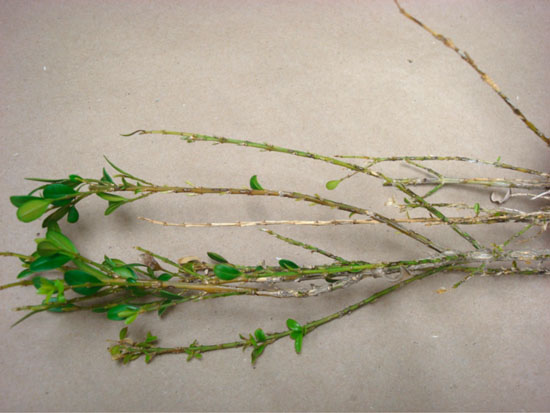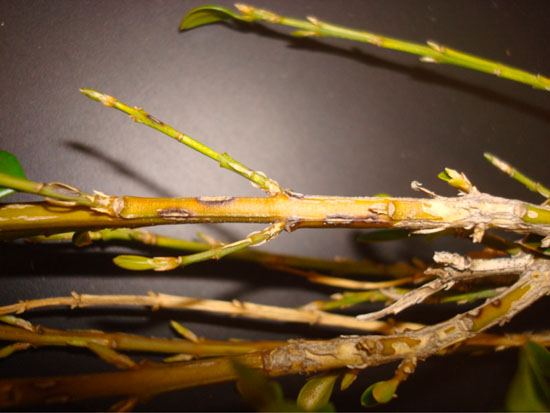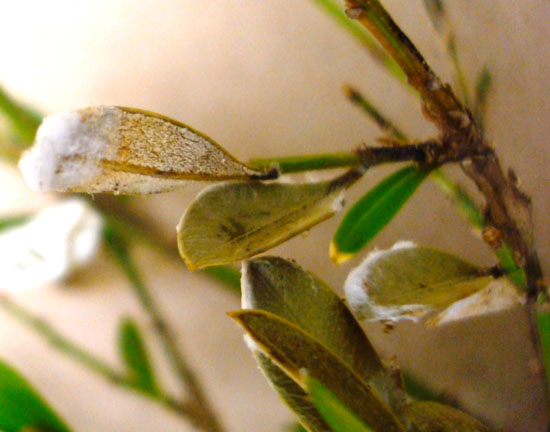Issue 2, April 30, 2012
A New Disease to the United States, but not yet detected in Illinois: Boxwood Blight
"Box blight" or "Boxwood Blight," was first described in the United Kingdom (UK) in the mid-1990's, but the disease was not formally identified. In 2002, this disease was found in New Zealand and was described and named as a new species, Cylindrocladium pseudonaviculatum. Later in the same year, the boxwood fungus described in the UK was named, Cylindrocladium buxicola. They are now known to be the same fungal disease. Since these first reports, this disease has been found throughout Europe.
In October of 2011, Boxwood Blight (Cylindrocladium pseudonaviculatum) (syn. C. buxicola), was detected in North Carolina and Connecticut. Later, there were more detections of this disease in the United States. Below is the current table that outlines the detection of Boxwood blight in the United States.
Date Confirmed in US | Location |
|---|---|
10/26/2011 | Surry County, North Carolina |
10/26/2011 | Middlesex, Fairfield, Hartford, New London Counties, Connecticut |
11/01/2011 | Carroll County, Virginia |
12/13/2011 | Providence County, Rhode Island |
12/14/2011 | Prince Georges County, Maryland |
12/19/2011 | Barnstable County, Massachusetts |
12/20/2011 | Washington County, Oregon |
12/23/2011 | Westchester County, New York |
1/24/2012 | Lancaster County, Pennsylvania |
3/28/2012 | Lake County, Ohio |
To date, this disease is known to infect all Boxwood or Buxus species as well as pachysandra. The fungus that causes Boxwood blight or Cylindrocladium pseudonaviculatum can infect all above ground parts of the plant, but does not appear to infect roots.
Symptoms may start out as dark or light brown spots (lesions) on leaves. Later, the spots develop dark borders, enlarge, and grow together. A concentric pattern of rings may be found within the spots. These infected leaves eventually turn brown or straw colored or "blight". Defoliation quickly occurs after infection of leaves. Heavily infected plants will drop most of their leaves, but, often times have a few green leaves remaining on top.

Green leaves emerging on top of infected plant, Picture taken by Stephanie Porter at Ohio Plant Clinic
This disease pathogen can also infect stems and cause distinct and diagnostic dark brown to black lesions to develop from the soil line to the shoot tips.

Lesions on stem, Picture taken by Stephanie Porter at Ohio Plant Clinic
The boxwood blight fungus form fungal structures that appear as white tuffs on the undersides of infected leaves and on black lesions. It may be possible to see this with a hand lens. The boxwood blight fungus has been reported to survive in cankers and fallen, infected leaves.

White, tuffs of fruiting structures on underside of blighted leaf, Picture taken by Stephanie Porter at Ohio Plant Clinic
It has been noted that this disease will not kill the plant; however this disease will repeatedly infect plants, which can weaken the plant and lead to death, especially for young plants or new transplants.
Boxwood blight can spread very rapidly during warm and humid conditions and can be a very serious problem in commercial production.
Some Other Boxwood Problems:

Volutella blight

Winterburn (Picture sent by Arun Aggarwal)
If you suspect Boxwood Blight on your boxwood or pachysandra, please contact and submit a sample to the U of I Plant Clinic (217-333-0519) immediately. (Stephanie Porter)
Author:
Stephanie Porter